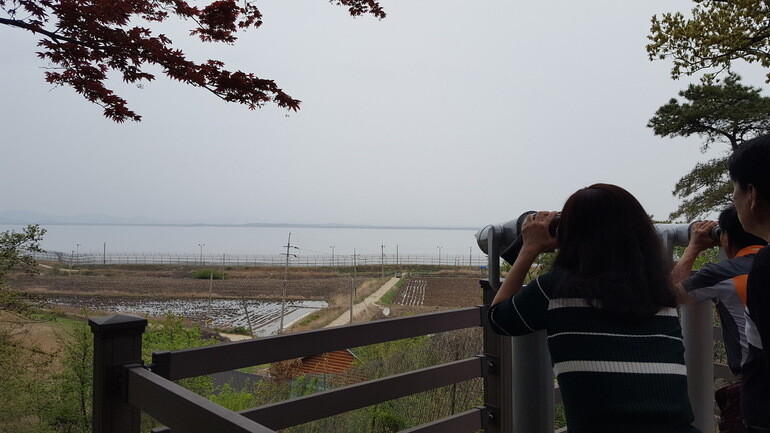hankyoreh
Links to other country sites 다른 나라 사이트 링크
[Reportage] Gyodong Island residents rejoice in climate of inter-Korean reconciliation

The “Korean Peninsula spring” has also come to Gyodong, an island of 47.14 square kilometers at the northern end of Incheon’s Gangwha County that has been designated a Civilian Control Zone (CCZ) in its entirety.
North Korea’s territory was clearly visible across the long barbed wire fence along Gyodong Island’s northern cost when I arrived on May 1 following a military inspection and the issuance of an entry pass. Yonbaek County in Hwanghae Province was just 2.5km away across the waters. Also present is an observation deck built by refugees from the North during the Korean War.
“She passed away without ever having the chance to set foot on her home soil again.” Song Soon-eop, a 54-year-old second-generation displaced North Korean, recalled her mother, who passed away last January at the age of 88. A native of Yonbaek, Song’s mother was never able to reunite with the husband she married in the North or her own mother and older sister.
“It tormented her all her life, being unable to forget the family she left back in the North or the landscape of her hometown. I spread her ashes in the waters off Incheon in the hope that perhaps her soul might return home,” a tearful Song said. Fifty-eight first- and second-generation displaced North Koreans live on Gyodong Island alone.

But a “ray of hope” emerged with the climate of reconciliation on the Korean Peninsula following the Apr. 27 Inter-Korean Summit, Song said. Residents of Gyodong Island and Ganghwa County hope the Panmunjeom Declaration will mean the opening of sea and land routes that have been closed off for 70 years.
“The loudspeaker broadcasts have stopped and the fear of being shelled has gone away. Hopefully they’ll open up the route to the North,” said Hwang Deok-hwan, an 80-year-old resident living near Gyodong’s Bukjin Pier.
The residents’ hope is that establishment of the special West Sea peace and cooperation zone mentioned in the Panmunjeom Declaration will lead to the designation of a special economic zone at Haeju and the use of its port, as well as shared use of the Han River estuary. Gyodong, which is located in that estuary, would occupy a key position in a special maritime peace and cooperation zone in the West Sea connecting the greater Seoul area with the Kaesong Industrial Complex and Haeju in North Korea.
For this reason, the City of Incheon is pushing to build an 80.44km “West Sea Peace Road” connecting Incheon International Airport with Ganghwa Island and Kaesong, along with a Gyodong “peace industrial complex.” The plans were also included among President Moon Jae-in’s election pledges for the Incheon area. Occupying 3.45 square kilometers, the industrial complex is to use a combination of South Korean land and capital and North Korean labor – a different approach from the Kaesong Industrial Complex, where the South supplied the capital investment and the North provided the land and workers.
The city predicted the Haeju special economic zone, Kaesong Industrial Complex, and the Gyodong peace industrial complex on the South Korean side will form a central axis for a distribution base. In addition to the land route furnished by the West Sea Peace Road, many also hope for the opening of an ocean route with direct lines between the ports at Incheon and Haeju.
By Lee Jung-ha, Incheon correspondent
Please direct comments or questions to [@hani.co.krenglish@hani.co.kr]
Editorial・opinion
![[Editorial] Does Yoon think the Korean public is wrong? [Editorial] Does Yoon think the Korean public is wrong?](https://flexible.img.hani.co.kr/flexible/normal/500/300/imgdb/original/2024/0417/8517133419684774.jpg) [Editorial] Does Yoon think the Korean public is wrong?
[Editorial] Does Yoon think the Korean public is wrong?![[Editorial] As it bolsters its alliance with US, Japan must be accountable for past [Editorial] As it bolsters its alliance with US, Japan must be accountable for past](https://flexible.img.hani.co.kr/flexible/normal/500/300/imgdb/original/2024/0417/6817133413968321.jpg) [Editorial] As it bolsters its alliance with US, Japan must be accountable for past
[Editorial] As it bolsters its alliance with US, Japan must be accountable for past- [Guest essay] Amending the Constitution is Yoon’s key to leaving office in public’s good graces
- [Editorial] 10 years on, lessons of Sewol tragedy must never be forgotten
- [Column] A death blow to Korea’s prosecutor politics
- [Correspondent’s column] The US and the end of Japanese pacifism
- [Guest essay] How Korea turned its trainee doctors into monsters
- [Guest essay] As someone who helped forge Seoul-Moscow ties, their status today troubles me
- [Editorial] Koreans sent a loud and clear message to Yoon
- [Column] In Korea’s midterm elections, it’s time for accountability
Most viewed articles
- 1‘Right direction’: After judgment day from voters, Yoon shrugs off calls for change
- 2[Editorial] Does Yoon think the Korean public is wrong?
- 3Where Sewol sank 10 years ago, a sea of tears as parents mourn lost children
- 4[Editorial] As it bolsters its alliance with US, Japan must be accountable for past
- 5Strong dollar isn’t all that’s pushing won exchange rate into to 1,400 range
- 6[Guest essay] Amending the Constitution is Yoon’s key to leaving office in public’s good graces
- 7Japan officially says compensation of Korean forced laborers isn’t its responsibility
- 8US, Japan and China move to become self-sufficient in semiconductors
- 9In 50 years, half of Koreans are expected to be 65 or older
- 10[News analysis] Watershed augmentation of US-Japan alliance to put Korea’s diplomacy to the test